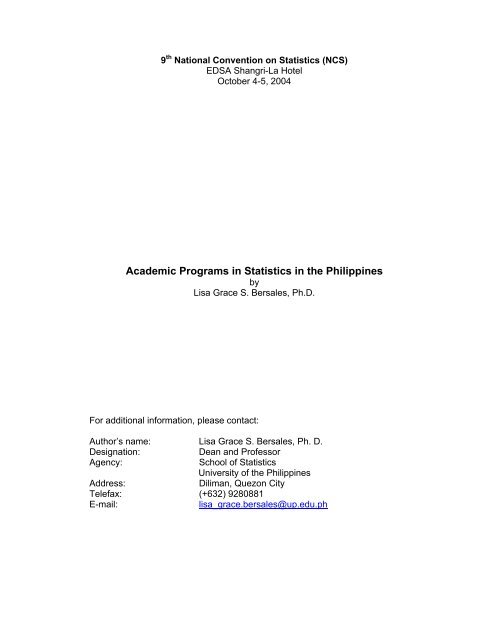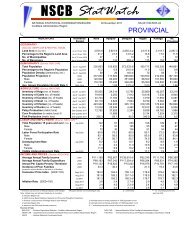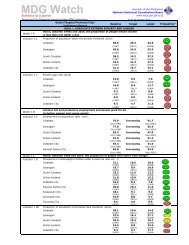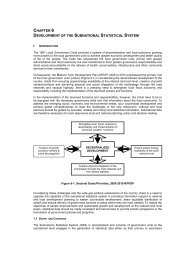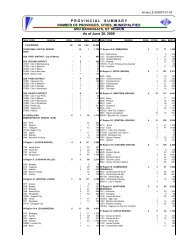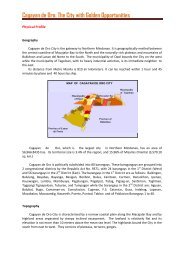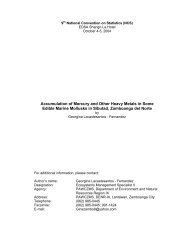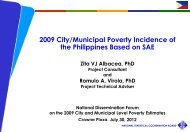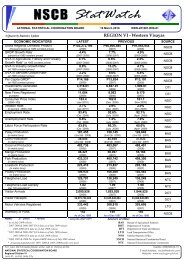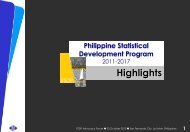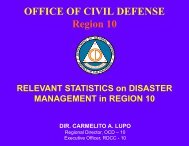Academic Programs in Statistics in the Philippines - NSCB
Academic Programs in Statistics in the Philippines - NSCB
Academic Programs in Statistics in the Philippines - NSCB
Create successful ePaper yourself
Turn your PDF publications into a flip-book with our unique Google optimized e-Paper software.
9 th National Convention on <strong>Statistics</strong> (NCS)EDSA Shangri-La HotelOctober 4-5, 2004<strong>Academic</strong> <strong>Programs</strong> <strong>in</strong> <strong>Statistics</strong> <strong>in</strong> <strong>the</strong> Philipp<strong>in</strong>esbyLisa Grace S. Bersales, Ph.D.For additional <strong>in</strong>formation, please contact:Author’s name: Lisa Grace S. Bersales, Ph. D.Designation:Dean and ProfessorAgency:School of <strong>Statistics</strong>University of <strong>the</strong> Philipp<strong>in</strong>esAddress:Diliman, Quezon CityTelefax: (+632) 9280881E-mail:lisa_grace.bersales@up.edu.ph
<strong>Academic</strong> <strong>Programs</strong> <strong>in</strong> <strong>Statistics</strong> <strong>in</strong> <strong>the</strong> Philipp<strong>in</strong>esbyLisa Grace S. Bersales 1ABSTRACTThe first academic program offered <strong>in</strong> <strong>the</strong> Philipp<strong>in</strong>es was <strong>the</strong> Master of Arts <strong>in</strong><strong>Statistics</strong> program of <strong>the</strong> Statistical Center, now <strong>the</strong> School of <strong>Statistics</strong>, of <strong>the</strong> Universityof <strong>the</strong> Philipp<strong>in</strong>es. This was <strong>in</strong>stituted <strong>in</strong> 1954. At present, many schools nationwide offerundergraduate and graduate programs <strong>in</strong> statistics. Thus, after 50 years, <strong>Statistics</strong> <strong>in</strong> <strong>the</strong>Philipp<strong>in</strong>es has found recognition as a discipl<strong>in</strong>e <strong>in</strong> itself. <strong>Academic</strong> <strong>in</strong>stitutions produce<strong>the</strong> statistical manpower for government, bus<strong>in</strong>ess and <strong>in</strong>dustry, and <strong>the</strong> academe.Fur<strong>the</strong>rmore, <strong>the</strong>y contribute research and tra<strong>in</strong><strong>in</strong>g services <strong>in</strong> <strong>the</strong> country.A survey of academic <strong>in</strong>stitutions that offer <strong>Statistics</strong> and AppliedMa<strong>the</strong>matics/<strong>Statistics</strong> programs show encourag<strong>in</strong>g statistics. However, <strong>the</strong>re is still aneed to attract more students, produce more graduates, enhance <strong>the</strong> academicprograms, and provide more facilities. The paper shall present <strong>the</strong>se statistics and giverecommendations on how to enhance <strong>the</strong>ir academic programs, attract more studentswith potential, and produce more graduates.I. The Birth of <strong>Statistics</strong> Education <strong>in</strong> <strong>the</strong> Philiip<strong>in</strong>esThe seed of higher level of education <strong>in</strong> <strong>Statistics</strong> <strong>in</strong> <strong>the</strong> Philipp<strong>in</strong>es wasplanted <strong>in</strong> 1952 when <strong>the</strong> first board of directors of <strong>the</strong> Philipp<strong>in</strong>e StatisticalAssociation discussed <strong>the</strong> possibility of establish<strong>in</strong>g an <strong>in</strong>ternational statisticalcenter <strong>in</strong> Manila under <strong>the</strong> dual sponsorship of <strong>the</strong> Philipp<strong>in</strong>e government and <strong>the</strong>United Nations (Lorenzo, 1953). This recommendation was a result of <strong>the</strong>irobservation that staff do<strong>in</strong>g statistical work <strong>the</strong>n did not have formal tra<strong>in</strong><strong>in</strong>g <strong>in</strong>statistics. At that time, college education offered only three units of elementarystatistics and <strong>the</strong>re were no undergraduate and graduate programs <strong>in</strong> statistics <strong>in</strong><strong>the</strong> Philipp<strong>in</strong>es.In 1953, <strong>the</strong> Statistical Center was established under a bilateral agreementbetween <strong>the</strong> Phlipp<strong>in</strong>e government and <strong>the</strong> United Nations. Its first academicprogram, Master of Arts <strong>in</strong> <strong>Statistics</strong>, was <strong>in</strong>stituted <strong>in</strong> 1954. It was formally turnedover to <strong>the</strong> University of <strong>the</strong> Philipp<strong>in</strong>es <strong>in</strong> 1963 and , <strong>in</strong> 1998, it was renamed <strong>the</strong>School of <strong>Statistics</strong> of <strong>the</strong> University of <strong>the</strong> Philipp<strong>in</strong>es <strong>in</strong> Diliman.II.Current <strong>Academic</strong> <strong>Programs</strong> <strong>in</strong> <strong>Statistics</strong>A study commissioned by <strong>the</strong> Technical Panel on Science andMa<strong>the</strong>matics of <strong>the</strong> Commission on Higher Education (CHED) listed eleven (11)schools offer<strong>in</strong>g academic programs <strong>in</strong> <strong>Statistics</strong> as of 1999 ( Bonzo andPatungan, 2000). At present, eighteen (18) schools offer such programs. Thefollow<strong>in</strong>g table, Table 1, lists <strong>the</strong>m and <strong>the</strong> programs <strong>the</strong>y offer: It should be notedthat <strong>the</strong> list does not <strong>in</strong>clude schools that may have programs <strong>in</strong> appliedma<strong>the</strong>matics which <strong>in</strong>clude statistics as a specialization but do not have formalstatistics programs.1 The author is a Professor of <strong>Statistics</strong> and Dean of <strong>the</strong> School of <strong>Statistics</strong> of <strong>the</strong> University of <strong>the</strong>Philipp<strong>in</strong>es <strong>in</strong> Diliman
University of Sou<strong>the</strong>astern Philipp<strong>in</strong>es <strong>in</strong>Davao CityWestern M<strong>in</strong>danao State University<strong>in</strong> Zamboanga City, Zamboanga delNorte* <strong>Academic</strong> Program not specifiedM.S. <strong>Statistics</strong>B.S. <strong>Statistics</strong>B.S. <strong>Statistics</strong>It is important to note that <strong>the</strong> curricular offer<strong>in</strong>gs are available nationwide.However, Ph.D. and Masteral offer<strong>in</strong>gs are concentrated <strong>in</strong> Luzon. OutsideLuzon, only <strong>the</strong> Iligan Institute of Technology of M<strong>in</strong>danao State University (MSU-IIT) offers a graduate degree( masteral level) <strong>in</strong> statistics. However, <strong>the</strong> CHEDstudy mentioned earlier cites two Ph.D. programs <strong>in</strong> Ma<strong>the</strong>matics that specialize<strong>in</strong> statistics. These are <strong>the</strong> Ph.D. <strong>in</strong> Ma<strong>the</strong>matical Sciences of <strong>the</strong> M<strong>in</strong>danaoPolytechnic State College and <strong>the</strong> Ph.D. <strong>in</strong> Ma<strong>the</strong>matics of MSU-IIT. Thus,although <strong>the</strong> M<strong>in</strong>danao region has no Ph.D. <strong>Statistics</strong> offer<strong>in</strong>gs, <strong>the</strong>re areMa<strong>the</strong>matics programs which focus on statistics. The Visayas region, <strong>the</strong>refore,needs more help <strong>in</strong> develop<strong>in</strong>g graduate level programs.A historical review of <strong>the</strong> <strong>in</strong>stitution of academic programs <strong>in</strong> statisticsoffered by <strong>the</strong> University of <strong>the</strong> Philipp<strong>in</strong>es <strong>in</strong> Diliman, Los Banos and Visayas(UPD, UPLB, UPV); MSU-IIT; and <strong>the</strong> Polytechnic University of <strong>the</strong> Philipp<strong>in</strong>es(PUP) shows <strong>the</strong> follow<strong>in</strong>g:Year Instituted: 1954 M.A. <strong>in</strong> <strong>Statistics</strong> (now abolished) <strong>in</strong> UPD1957 M.S. <strong>Statistics</strong> <strong>in</strong> UPD1964 B. of <strong>Statistics</strong> <strong>in</strong> UPD1967 B.S. <strong>Statistics</strong> <strong>in</strong> UPD1968 Master of <strong>Statistics</strong> <strong>in</strong> UPD1969 Ph.D. <strong>Statistics</strong> <strong>in</strong> UPD1970 M.S. Experimental <strong>Statistics</strong> <strong>in</strong> UPLB1972 B.S. <strong>Statistics</strong> <strong>in</strong> UPLB1977 M.S. <strong>Statistics</strong> <strong>in</strong> UPLB1979 Master <strong>in</strong> Applied <strong>Statistics</strong> <strong>in</strong> PUP1980 B.S. <strong>Statistics</strong> <strong>in</strong> MSU-IIT1985 Ph.D. <strong>Statistics</strong> <strong>in</strong> UPLB1995 Master of Applied <strong>Statistics</strong> of MSU-IIT2000 New Master <strong>in</strong> Applied <strong>Statistics</strong> <strong>in</strong> PUP2001 B.S. <strong>Statistics</strong> <strong>in</strong> UPV2004 M.S. <strong>Statistics</strong> <strong>in</strong> MSU-IITThe School of <strong>Statistics</strong> academic programs started with <strong>the</strong> tra<strong>in</strong><strong>in</strong>g ofma<strong>in</strong>ly government statisticians. The Institute of <strong>Statistics</strong>’ programs developedfrom <strong>the</strong> <strong>Statistics</strong> Laboratory of <strong>the</strong> College of Agriculture of UPLB. The programof UPV was developed by its College of Arts and Sciences and <strong>the</strong> programs ofMSU-IIT were developed by its College of Science. Alumni of <strong>the</strong> School of<strong>Statistics</strong> spearheaded <strong>the</strong>se developments.The Master of Applied <strong>Statistics</strong>(MAS) of PUP just like <strong>the</strong> first academicprogram of <strong>the</strong> School of <strong>Statistics</strong> also resulted from a bilateral agreement. The
MAS program was formalized <strong>in</strong> 1979 as an academic program of PUP through amemorandum of agreement between <strong>the</strong> Philipp<strong>in</strong>e National <strong>Statistics</strong>Office(PNSO) and PUP. This was done through <strong>the</strong> efforts of Dr. Tito A. Mijares,<strong>the</strong>n <strong>the</strong> Executive Director of PNSO, who realized <strong>the</strong> need for those engaged <strong>in</strong><strong>the</strong> practice of statistics to undergo fur<strong>the</strong>r studies <strong>in</strong> statistical <strong>the</strong>ory, methodsand data analysis. The program was fur<strong>the</strong>r enhanced <strong>in</strong> 2000(Africa andIgnacio, 2001).III.FacultyProfil<strong>in</strong>g faculty of schools that offer academic programs <strong>in</strong> statistics yields<strong>the</strong> conclusion that <strong>the</strong>re is still a dearth <strong>in</strong> <strong>the</strong> teach<strong>in</strong>g workforce. The CHEDstudy reported that, <strong>in</strong> 1999, all <strong>the</strong> schools <strong>in</strong> <strong>the</strong> survey had, on <strong>the</strong> average,thirteen (13) full-time faculty and three(3) part-time faculty. Fur<strong>the</strong>rmore, <strong>the</strong>faculty of eleven(11) schools that offer statistics programs had a workforce oftwenty one(21) faculty with Ph.D. <strong>in</strong> <strong>Statistics</strong>, forty five(45) with Masteraldegrees <strong>in</strong> <strong>Statistics</strong>, and twenty n<strong>in</strong>e(29) with Bachelor’s degrees <strong>in</strong> <strong>Statistics</strong>.An ongo<strong>in</strong>g study on scientific and technological human resources <strong>in</strong> <strong>the</strong>Philipp<strong>in</strong>e education sector be<strong>in</strong>g conducted by <strong>the</strong> U.P. Statistical CenterResearch Foundation, Inc., <strong>the</strong> research foundation of <strong>the</strong> U.P. School of<strong>Statistics</strong>, reported that <strong>the</strong> estimated number of faculty with <strong>Statistics</strong> degrees issignificantly fewer than those with Ma<strong>the</strong>matics degrees. Table 2 below presents<strong>the</strong> statistics.Table 2. Number of Faculty <strong>in</strong> <strong>the</strong> Basic and Ma<strong>the</strong>matical SciencesBy Degree, Philipp<strong>in</strong>es, June 2001*DegreeNumber of FacultyM. Actuarial Science 1M.S./M.A. Applied Ma<strong>the</strong>matics/Ma<strong>the</strong>matics 507D.S./Ph.D. Applied Ma<strong>the</strong>matics/Ma<strong>the</strong>matics/Ma<strong>the</strong>matical Science 81M./M.S. <strong>Statistics</strong>/Applied <strong>Statistics</strong> 64Ph.D. <strong>Statistics</strong>/<strong>Statistics</strong> and Research 17M.A./M.S. General Science/M. Applied Science 9M./M.S. Science(specialization not specified) 30M. Science o<strong>the</strong>r sciences) 3Ph.D. ( o<strong>the</strong>r sciences) 1Ph.D. <strong>in</strong> Science (specialization not specified) 3*Source: Prelim<strong>in</strong>ary Report of Projection of Scientific and TechnologicalHuman Resources <strong>in</strong> <strong>the</strong> Philipp<strong>in</strong>e Education Sector, a U.P. StatisticalCenter Research Foundation, Inc. Project for CHEDA closer look at <strong>the</strong> profile of faculty of selected schools shows that,except for UPLB, majority of <strong>the</strong> faculty have masteral degree. The follow<strong>in</strong>gtable, Table 3, shows <strong>the</strong> distribution of faculty.
Table 3. Regular Faculty of Selected SchoolsBy Highest Degree Earned, 2004Highest Degree Earned UPD UPLB UPV*MSU-IIT**PUP-BSStat***Ph.D. Math/Stat 6 4 1 5 0Ph.D. o<strong>the</strong>rspecialization 0 1 0 0 2M.S. Stat/Math 12 7 7**** 8 2B.S. Stat/Math 7 14 4 4 1Total 25 26 12 17 5*<strong>in</strong>cludes only faculty teach<strong>in</strong>g <strong>in</strong> <strong>the</strong> Stat program**<strong>in</strong>cludes faculty teach<strong>in</strong>g <strong>in</strong> B.S. <strong>Statistics</strong>, Master of Applied <strong>Statistics</strong>,specializ<strong>in</strong>g <strong>in</strong> Ma<strong>the</strong>matical <strong>Statistics</strong>***two(2) are full-time and three(3) are part-time, 2003 data****2 are on study leavePh.D. MathAll of <strong>the</strong> 16 faculty of PUP <strong>in</strong> its MAS program <strong>in</strong> 2004 are part-time.Majority of <strong>the</strong>se professors are from <strong>the</strong> National <strong>Statistics</strong> Office.IV.Enrolment TrendsNebres (1998) noted <strong>the</strong> lack of sufficient numbers of talentedundergraduate students <strong>in</strong> <strong>the</strong> ma<strong>the</strong>matical sciences. This lack <strong>in</strong> <strong>the</strong>undergraduate level will, consequently, translate to a lack of students <strong>in</strong> <strong>the</strong>graduate level. The CHED study also noted a decl<strong>in</strong>e <strong>in</strong> enrolment <strong>in</strong>undergraduate programs <strong>in</strong> statistics from 1996 to 1999. In 2001, estimatedenrolment statistics show a lower level of enrolment <strong>in</strong> statistics at all levelscompared with that <strong>in</strong> ma<strong>the</strong>matics. The follow<strong>in</strong>g table, Table 4, shows <strong>the</strong>seestimates.Table 4. Number of Enrolled <strong>in</strong> Undergraduate and Graduate <strong>Programs</strong> In<strong>the</strong> Basic and Ma<strong>the</strong>matical Sciences* Philipp<strong>in</strong>es, June 2001ProgramLevelB.S. M.S. Ph.D.Applied Ma<strong>the</strong>matics/Ma<strong>the</strong>matics 4845 617 98Math Major <strong>in</strong> Computer Science 1725Math-Stat 1<strong>Statistics</strong>/Applied <strong>Statistics</strong> 1317 104 20General/Applied Science 353 77Science(specialization not specified) 21*Source: Prelim<strong>in</strong>ary Report of Projection of Scientific and Technological Human Resources <strong>in</strong><strong>the</strong> Philipp<strong>in</strong>e Education Sector, a U.P. Statistical Center Research Foundation, Inc. Project forCHEDUndergraduate enrolment <strong>in</strong> UPD shows some decl<strong>in</strong>e while those <strong>in</strong>UPLB, UPV and MSU-IIT are higher <strong>in</strong> 2004 compared to <strong>the</strong> previous year. Thefollow<strong>in</strong>g tables, Table 5.1 and Table 5.2, show <strong>the</strong> statistics.
Table 5.1 Distribution of Enrolled Undergraduate Freshmen <strong>in</strong> SelectedSchools, SY 1998-1999 to SY 2004-2005Number of Enrolled Freshmen <strong>in</strong> <strong>the</strong> B.S. <strong>Statistics</strong>Program*MSU-School Year UPD UPV UPLB IITPUP1998-1999 124 program 30 37 521999-2000 110 not yet 28 44 602000-2001 115 offered 38 33 622001-2002 114 20 36 10 522002-2003 115 14 46 25 not available2003-2004 106 12 42 21 not available2004-2005 103 18 48 25 not available*First semester onlyTable 5.2 Distribution of Enrolled Undergraduate Students <strong>in</strong> SelectedSchools, SY 1998-1999 to SY 2004-2005Mean Enrolment per Semester <strong>in</strong> <strong>the</strong> B.S. <strong>Statistics</strong>ProgramSchool Year UPD UPV MSU-IIT PUP1998-1999 466 program 62 1821999-2000 443 not yet 68 1902000-2001 463 offered 56 1722001-2002 47719(1 st yearonly) 36 1902002-2003 46128.5(1 st and 2 ndyr) 51 not available2003-2004 44135.5(1 st to 3 rdyr) 50 not available2004-2005 410* 52* 54* not available*First Semester onlyUPLB statistics not availableTable 5.2 Distribution of Enrolled Undergraduate Students <strong>in</strong> SelectedSchools, SY 1998-1999 to SY 2004-2005Mean Enrolment per Semester <strong>in</strong> <strong>the</strong> B.S. <strong>Statistics</strong>ProgramSchool Year UPD UPV UPLB MSU-IIT PUP1998-1999 466 program 114 62 1821999-2000 443 not yet 112 68 1902000-2001 463 offered 128 56 17219(1 st year2001-2002 477 only) 149 36 19028.5(1 st and 2 nd2002-2003 461 yr) 182 512003-2004 441 35.5(1 st to 3 rd 193 50 notnotavailable
yr)2004-2005 410* 52* 226* 54**First Semester onlyavailablenotavailableEnrolment <strong>in</strong> <strong>the</strong> graduate programs, on <strong>the</strong> o<strong>the</strong>r hand, seems to bedifferent when compar<strong>in</strong>g statistics of UPD and UPLB. UPD experienced<strong>in</strong>crease <strong>in</strong> enrolment <strong>in</strong> <strong>the</strong> current school year. Current figures for UPLB are notavailable. However, available statistics seem to <strong>in</strong>dicate some decl<strong>in</strong>e. Table 5.3below shows <strong>the</strong> statistics.Table 5.3 Distribution of Enrolled Graduate Students <strong>in</strong> Selected Schools,SY 1998-1999 to SY 2004-2005Mean Enrolment per Semester <strong>in</strong> <strong>the</strong> Graduate <strong>Programs</strong> <strong>in</strong><strong>Statistics</strong>UPD UPLB MSU-IITSchoolYearM.S.StatMasterof StatPh.D.StatM.S.Stat Ph.D. Stat MAS1998-1999 19 36 11 17 8 111999-2000 30 47 13 17 4 172000-2001 29 63 16 15 3* 132001-2002 35 177 14 13*2002-2003 38 75 152003-2004 61 86 162004-2005 68* 110* 21**First Semester onlynotavailablenotavailablenotavailableM.S.Statnotavailable 13 Programnotavailable 8 Offerednotavailable 8 In 2004notavailable 10* 17A closer look at <strong>the</strong> profile of graduate students of <strong>the</strong> School of <strong>Statistics</strong><strong>in</strong> UPD, reveals that majority of enrolled students are work<strong>in</strong>g students from <strong>the</strong>private sector. The School now schedules graduate classes after 6 p.m. onweekdays as well as dur<strong>in</strong>g Saturdays. This is one factor attributed to <strong>the</strong><strong>in</strong>crease <strong>in</strong> enrolment. Fur<strong>the</strong>rmore, <strong>the</strong>re is now more recognition of <strong>the</strong> role ofstatistics <strong>in</strong> bus<strong>in</strong>ess and <strong>in</strong>dustry. This also contributes to <strong>the</strong> <strong>in</strong>crease <strong>in</strong>enrolment. Ano<strong>the</strong>r important factor <strong>in</strong> <strong>the</strong> <strong>in</strong>creased enrolment is <strong>the</strong> availabilityof scholarships. The follow<strong>in</strong>g scholarships were and are made available forgraduate students <strong>in</strong> statistics <strong>in</strong> UPD:
List of Graduate Scholarships on <strong>Statistics</strong>Name of ScholarshipDurationBAS-AASS Master of <strong>Statistics</strong> Fellowship June 1990 - 1992UNDP-SESP (Statistical Education Support June 5, 1985 - December 31,Project)1990ESEP( Eng<strong>in</strong>eer<strong>in</strong>g and Science Education Jan 1992 - 1997, extendedSupport Program)up to 1999PCASTRD (Philipp<strong>in</strong>e Center for AdvancedJune 1989 to dateScience and Technology Research andDevelopment)Reeng<strong>in</strong>eer<strong>in</strong>g <strong>the</strong> Philipp<strong>in</strong>e Statistical System- June 2001 – 2005SRTCAvailability of scholarships has also been cited to <strong>in</strong>crease enrolment <strong>in</strong>PUP’s MAS program (Africa and Ignacio, 2001).V. Graduation TrendsThe School of <strong>Statistics</strong> has graduated <strong>the</strong> follow<strong>in</strong>g number of studentsas of Summer 2004:<strong>Academic</strong> ProgramNumber of GraduatesBachelor of <strong>Statistics</strong>* 92Certificate <strong>in</strong> <strong>Statistics</strong>* 8Diploma <strong>in</strong> <strong>Statistics</strong>* 50B.S. <strong>Statistics</strong> 2198MOS 183MS 127Ph.D. 16*Not Offered AnymoreOn <strong>the</strong> average, <strong>the</strong> number of graduates <strong>in</strong> <strong>the</strong> undergraduate programsfrom UPD and UPLB are 54 and 26 per year, resp, from SY 1986-1987 to SY2002-2003. However, <strong>the</strong> number of graduates has been fluctuat<strong>in</strong>g for UPD witha generally <strong>in</strong>creas<strong>in</strong>g trend. UPLB, however, seems to have decl<strong>in</strong>ed <strong>in</strong> <strong>the</strong>recent years. This may be a function of enrolment data. The follow<strong>in</strong>g chartshows <strong>the</strong> U.P. School of <strong>Statistics</strong> graduation trend for <strong>the</strong> undergraduateprogram:
Number of B.S. <strong>Statistics</strong> GraduatesU.P. School of <strong>Statistics</strong>SY 1986-1987 to SY 2003-2003120100Number of Graduates8060402001992-19931990-19911988-19891986-1987School Year2002-20032000-20011998-19991996-19971994-1995The number of graduates <strong>in</strong> <strong>the</strong> graduate programs, however, seems tohave stabilized at a lower level <strong>in</strong> <strong>the</strong> recent years for UPD and UPLB. PUPexperienced <strong>in</strong>creases <strong>in</strong> <strong>the</strong> number of graduates from <strong>the</strong> MAS program <strong>in</strong> <strong>the</strong>recent years and this is attributed to <strong>the</strong> offer<strong>in</strong>g of <strong>the</strong> comprehensive exammode over <strong>the</strong>sis for graduation(Africa and Ignacio,2001). Ano<strong>the</strong>r factorattributed to better graduation rate is <strong>the</strong> availability of scholarships andfellowships for <strong>the</strong> students. This was mentioned by Africa and Ignacio(2001) andthis has been <strong>the</strong> experience by <strong>the</strong> School of <strong>Statistics</strong>. The high level ofgraduation from <strong>the</strong> MOS program <strong>in</strong> <strong>the</strong> late 80s and early 90s is due to <strong>the</strong>BAS-AAPP fellowship. The chart below shows graduation levels from <strong>the</strong> Schoolof <strong>Statistics</strong>’ graduate programs:Number of Graduates <strong>in</strong> <strong>the</strong> Graduate <strong>Programs</strong> of <strong>the</strong> U.P. Schoolof <strong>Statistics</strong>, SY 1986- 1987 to SY 2002-200330Number of Graduates252015105MOSMSPh.D.02002-20032000-20011998-19991996-19971994-19951992-19931990-19911988-19891986-1987School Year
The table below, Table 6, shows graduation statistics.Table 6. Distribution of Graduates of Selected Schools by <strong>Academic</strong> ProgramSY 1986 -1987 to SY 2003-2004SchoolUPD UPLB PUP MSU-IITYear B.S. MOS MS Ph.D. B.S. MS Ph.D. MAS B.S. MAS1986-1987 43 8 5 1 54 8 program 11987-1988 31 6 5 0 44 5started<strong>in</strong> 1 2 program1988-1989 38 5 7 3 32 4 1985 0 4 started1989-1990 43 16 4 3 22 9 1 2 <strong>in</strong> 19951990-1991 27 15 7 1 26 3 0 31991-1992 52 26 3 0 36 2 2 0 11992-1993 61 9 8 1 43 4 1 1 21993-1994 40 8 3 0 26 2 1 0 41994-1995 42 4 6 1 14 1 1 1 71995-1996 39 2 5 1 25 2 1 0 41996-1997 39 5 5 0 24 1 1 0 51997-1998 54 5 3 0 16 2 1 0 21998-1999 85 7 6 0 23 4 2 10 81999-2000 63 1 2 1 15 0 0 7 62000-2001 76 2 3 1 15 1 0notavailable 5 52001-2002 102 5 3 0 11 4 2notavailable 6 02002-2003 90 2 3 2 11 1 0notavailable 6 22003-2004 97 6 3 0notavailable 12 0VI.Research and Extension ActivitiesResearch be<strong>in</strong>g done by faculty and students of <strong>the</strong> schools offer<strong>in</strong>gstatistics has been varied and useful. They range from <strong>the</strong>oretical to applied andencompass work <strong>in</strong> many areas. These areas <strong>in</strong>clude ma<strong>the</strong>matical statistics,biostatistics, sampl<strong>in</strong>g, multivariate statistics, categorical data analysis,econometrics, time series analysis . They use varied data from different o<strong>the</strong>rdiscipl<strong>in</strong>es.Extension services <strong>in</strong>clude tra<strong>in</strong><strong>in</strong>g for both government and private sectoras well as consult<strong>in</strong>g services with<strong>in</strong> <strong>the</strong> schools. Graduate programs now <strong>in</strong>cludestatistical consult<strong>in</strong>g. The graduate programs of <strong>the</strong> School of <strong>Statistics</strong> and <strong>the</strong>new MAS of PUP are examples.
VII.Comput<strong>in</strong>g LaboratoriesComput<strong>in</strong>g laboratories hous<strong>in</strong>g updated hardware and software areavailable <strong>in</strong> a number of schools and faculty and students have <strong>the</strong> use of<strong>in</strong>ternet for research. The CHED study mentioned specifically <strong>the</strong> UP systemschools with statistics programs and MSU-IIT. O<strong>the</strong>r schools need more supportfor <strong>the</strong>se facilities.VIII.Recommendations to Enhance <strong>Statistics</strong> EducationNebres(1998) mentioned that <strong>the</strong> impression one gets from availableliterature is that <strong>the</strong> need of <strong>in</strong>dustry has not been met by academic programs <strong>in</strong>statistics. The follow<strong>in</strong>g recommendations were enumerated to address thisneed:• undergraduate and graduate programs should focus on <strong>the</strong> needsof <strong>in</strong>dustry• undergraduate and graduate programs <strong>in</strong> statistics should bedeveloped• CHED should encourage jo<strong>in</strong>t programs <strong>in</strong> math and o<strong>the</strong>rdiscipl<strong>in</strong>es• develop l<strong>in</strong>kage between academe and <strong>in</strong>dustryMijares(1998) as a supplement to Nebres(1998) wrote that <strong>the</strong> follow<strong>in</strong>gmay be done <strong>in</strong> <strong>the</strong> discipl<strong>in</strong>e of statistics:• promote statistical culture <strong>in</strong> scientific undertak<strong>in</strong>gs by cont<strong>in</strong>u<strong>in</strong>g<strong>the</strong> National Convention <strong>in</strong> <strong>Statistics</strong>• establish l<strong>in</strong>kages and reach out to o<strong>the</strong>r professional societies and<strong>in</strong>stitutions• ensure broad <strong>in</strong>dividual and <strong>in</strong>stitutional memberships <strong>in</strong> <strong>the</strong>Philipp<strong>in</strong>e Statistical Association• encourage more colleges/universities to offer statistical courses• statistical departments to establish l<strong>in</strong>kages with o<strong>the</strong>r departmentsand promote jo<strong>in</strong>t research activitiesThe recommendations above should <strong>in</strong>deed be pursued. It should benoted that s<strong>in</strong>ce 1998 more schools have offered statistics programs nationwide.The previous National Convention on <strong>Statistics</strong> was well-attended. The nextConvention scheduled <strong>in</strong> October 2004 is expected to have <strong>the</strong> same receptionby <strong>the</strong> statistics community and those <strong>in</strong>terested <strong>in</strong> <strong>the</strong> applications of statistics.L<strong>in</strong>kages are important <strong>in</strong> fur<strong>the</strong>r develop<strong>in</strong>g statistics education and this isrecognized by <strong>the</strong> INSTAT of UPLB and <strong>the</strong> School of <strong>Statistics</strong> of UPD. Thesecond jo<strong>in</strong>t student-faculty of <strong>the</strong>se two <strong>in</strong>stitutions was held <strong>in</strong> September 25. Itis recommended that this collaboration be extended to <strong>in</strong>clude o<strong>the</strong>r schoolsoffer<strong>in</strong>g statistics academic programs.The Philipp<strong>in</strong>e Statistical Association(PSA) cont<strong>in</strong>ues to nurture <strong>the</strong>development of statistics <strong>in</strong> <strong>the</strong> country. It has provided academe with venues to<strong>in</strong>teract with <strong>the</strong> Philipp<strong>in</strong>e statistical system. It has contributed much to <strong>the</strong>advocacy of statistics and has lobbied for <strong>the</strong> ma<strong>in</strong>tenance of statistics
scholarships and fellowships. It is noteworthy that <strong>the</strong> PSA is currently assess<strong>in</strong>gits role and has started to reach out more to <strong>the</strong> private sector. All <strong>the</strong>se activitiespo<strong>in</strong>t to <strong>the</strong> importance of l<strong>in</strong>kages.The Statistical Research and Tra<strong>in</strong><strong>in</strong>g Center has actively supportedacademe through its collaboration with academe <strong>in</strong> sponsor<strong>in</strong>g lectures ofresource persons.The statistical community should develop l<strong>in</strong>kage with o<strong>the</strong>r discipl<strong>in</strong>es-<strong>the</strong>social sciences, <strong>the</strong> medical sciences, bus<strong>in</strong>ess and f<strong>in</strong>ance, economics,ma<strong>the</strong>matics.The academe should establish more collaboration among <strong>the</strong>mselves.Collaboration could <strong>in</strong>clude co-advis<strong>in</strong>g for students to <strong>in</strong>crease graduation rate.Research can <strong>the</strong>n thrive more.Institutions offer<strong>in</strong>g statistics programs should cont<strong>in</strong>ue to communicate tofund<strong>in</strong>g <strong>in</strong>stitutions <strong>the</strong> need for statistics fellowships and scholarships. Schoolsshould regularly contact its alumni who can provide not just f<strong>in</strong>ancial support butalso more network<strong>in</strong>g and feedback on <strong>the</strong> current needs of employers. With <strong>the</strong>proper l<strong>in</strong>kages <strong>in</strong> place and thriv<strong>in</strong>g, higher level of statistics education <strong>in</strong> <strong>the</strong>Philipp<strong>in</strong>es shall <strong>in</strong>deed be higher level.REFERENCESAFRICA, TOMAS P. AND IGNACIO, ROSALINDA V. (2001) The Master <strong>in</strong>Applied <strong>Statistics</strong> Program : Bilateral <strong>Academic</strong> Cooperation <strong>in</strong> <strong>the</strong>Philipp<strong>in</strong>es (a paper presented at <strong>the</strong> 2001 ISI conference <strong>in</strong> Korea)BERSALES, LISA GRACE S. (2003). State of Higher Level <strong>Statistics</strong> Education<strong>in</strong> <strong>the</strong> Philipp<strong>in</strong>es, a paper presented at <strong>the</strong> Tito A. Mijares ResearchConference.BONZO, DANIEL AND PATUNGAN, WELFREDO (2000) Assessment of<strong>Statistics</strong> Education <strong>in</strong> <strong>the</strong> Philipp<strong>in</strong>es, F<strong>in</strong>al report of <strong>the</strong> study for CHEDMIJARES, TITO (1998) <strong>Statistics</strong> <strong>in</strong> <strong>the</strong> Philipp<strong>in</strong>es and <strong>the</strong>ir Application (Asupplemental <strong>in</strong>fo on BF Nebres’ paper)NEBRES, BIENVENIDO F. (1998) Assessment of <strong>the</strong> Ma<strong>the</strong>matics Sciences <strong>in</strong><strong>the</strong> Philipp<strong>in</strong>es and <strong>the</strong>ir Applications <strong>in</strong> IndustryPRELIMINARY REPORT UPSCRF project of DOST-SEI Projection of Scientificand Technological Human Resources <strong>in</strong> Philipp<strong>in</strong>e Education Sector(2002)


